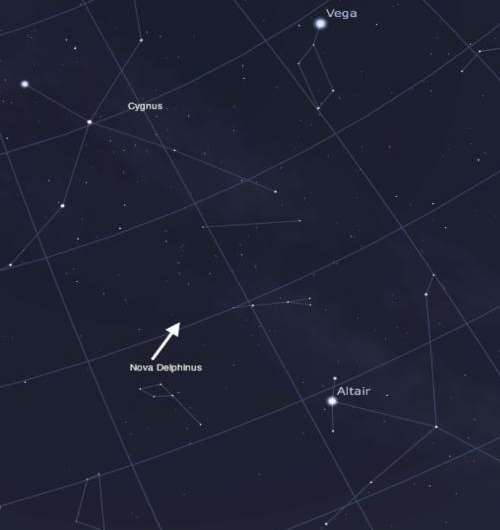Bright nova in the constellation of Delphinus

A bright nova has recently been discovered in the constellation of Delphinus (The Dolphin). The discoverer was Koichi Itagaki, in Japan who used an 18 cm reflecting telescope with a CCD camera. The nova was confirmed late on August 14 at a magnitude of 6.3 (in a dark sky the faintest naked-eye stars are approximately 6.0 magnitudes - the lower the magnitude the brighter a star). Unusually, the nova continued to brighten after discovery reaching magnitude 4.5 according to the American Association of Variable Star Observers. This made it the brightest nova visible in the northern hemisphere sky since Nova Aql 1999 (V1494 Aql) which brightened to magnitude 4.0.
The recent nova lies near the summer triangle of the bright stars Vega (in the constellation the Lyra), Deneb (Cygnus) and Altair (Aquila). The chart on the right will give you a general idea of where to look. Vega is the brightest star in the summer sky. Look south from Vega and you'll find Altair.
The following link to the Sky and Telescope Web site gives a good finding chart to spot the Nova's exact position. Depending on how dark your sky is, you made need small binoculars. (Sky and Telescope).
Nova explosions occur in binary systems composed of a star similar to our Sun but only ~1/10 of its mass, and a star called a white dwarf. The white dwarf has a mass roughly half of the Sun but squeezed into the size of the Earth. Since these stars are orbiting around each other on a short timescale - several hours - material can get dragged from one star to the other. Over time (hundreds or thousands of years) this material can build up on the surface of the white dwarf and eventually detonate as a nuclear explosion. In the case of this new nova, the system has brightened by 100,000 times its previous brightness. By studying them scientists can gain a better understanding of the physical processes which are occurring in these objects. This nova as well as being bright, has been detected in Gamma-rays - only the fourth known nova to be detected at these high energies.
Provided by Armagh Observatory



















